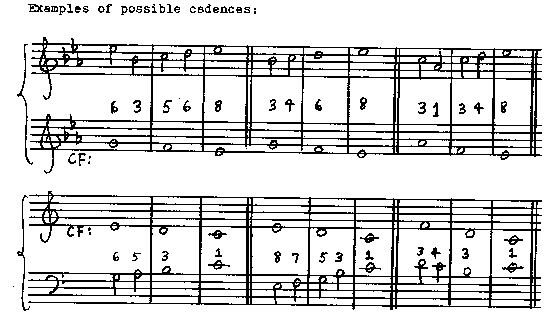|
Back to the Music 103 home page...
In the second species, two half-notes of counterpoint are set against each whole-note of the c.f. (except as specified below). This results in the first occurrence of meter: the first half-note of each bar is a downbeat (strong beat) while the second is an upbeat (weak beat). The metric difference between downbeat and upbeat -- a difference between something primary and something secondary -- parallels the difference between consonance and dissonance in the world of intervals. It therefore provides a natural setting for vertical dissonance, which now makes its first appearance in the exercises of species counterpoint (see below).
Beginning
- The intervallic requirements for the beginning are the same as those of the first species in two voices.
- The first bar of the counterpoint may contain either two half-notes or a half-rest followed by a half-note.
Main Body
- The counterpoint aims for melodic fluency and equilibrium just as the c.f. does. It is therefore governed by the same rules and tendencies; in particular, dissonant leaps are prohibited in the second species voice just as in the c.f.
- The half-note on the downbeat of each bar must be consonant with the c.f.
- The half-note on the upbeat of each bar of the main body may be either consonant or dissonant with the c.f. If it is dissonant, it must enter by step and must continue by step in the same direction. Such a dissonant tone is called a passing tone. (This is the only dissonance permitted in the second species.)
- A perfect consonance on the downbeat must not be approached in similar motion. Consecutive bars must not have perfect consonances of the same numerical name on the downbeat:

- The unison may occur on the upbeat, and only on the upbeat.
- The half-note voice may not repeat a tone, either within the bar or across the bar line.
Ending (Cadence)
- The final bar of the counterpoint must contain only the tonic tone as a whole-note, at either the 8ve or the unison of the c.f.
- The penultimate bar may contain either two half-notes or a single whole-note.
- The penultimate tone of the counterpoint (whether a half- or a whole-note) must be scale degree 7 if the c.f. has scale degree 2, and (vice-versa) scale degree 2 if the c.f. has scale degree 7.

Back to the Music 103 home page...
Copyright © 1993 by John Rothgeb
|

